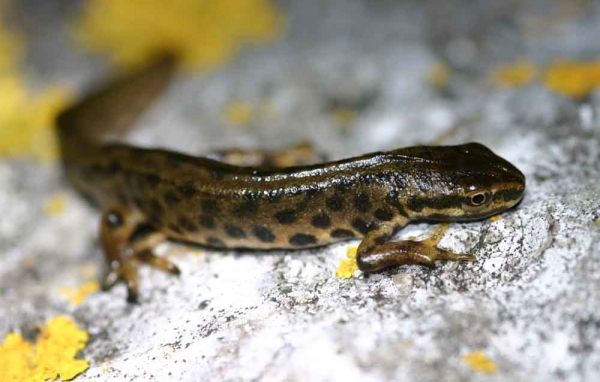
Common or Smooth newt (Triturus vulgaris) – pic taken from Froglife
Following up the first, dimly lit newt survey on the 18th April , we returned to the Ecology center ponds last week with newly bought batteries in tow that would hold their charge all night and dazzle and bamboozle any unwary amphibians!
…only we didn’t have the batteries, because they hadn’t arrived yet. Dang.
Unperturbed, we forged on with our intrepid expedition into the darkness, slightly unimpressive spotlights searching through the gloom. (If I’m honest, it was a perfectly pleasant and mild evening, but what’s the point in writing this stuff down if I can’t use a little poetic embellishment?)
We decided to start with the main pond this time, as we didn’t manage to thoroughly survey it last time due to the lamps flickering and dying. Even just as we started counting, we were aware that the newt’s crests were noticeably larger and more obvious than the previous week, growing as we get further into the breeding season. we planned to keep track of the number of males and females on our next outing.
It was good to return to the main pond with our lamps at full brightness this time, as we actually found a whopping 42 smooth newts (Triturus vulgaris) and a common toad (Bufo bufo) on our walk around the pond perimeter. With this many easily visible, there seems to be a large and healthy population in the pond, many flashing us with their orange tummies and conspicuous ridged crests as we slowly scanned over the water.
In regards to newts (and ridiculously fat leeches) per square meter, though, the smaller pool next to the pond shed took the cake. We found 20, nearly half as many again, in this small pool which can only be a tenth of the size of the main pond, if that. Perhaps this small pool is where the truly hip newts hang out. Sure, they’ll have to share their space with leeches, but they know they won’t be bothered by the lame old square newts of the main pond… or more likely, something about the botanical make up of the pond or adundance of food favours newt breeding. For instance they may use the leaves of the Brooklime (Veronica beccabunga) growing there to protect their eggs. I suppose that with further surveying and monitoring we can find out if this pool really is the hip hang out that I think it is.
Unfortunately, once again the lamps were flickering and failing us after this, and the smaller, shallower ponds seemed to have been more churned up by the small amount of rain earlier in the day. Despite that, a quick squizz at the various remaining ponds at the Ecology Center did turn up a few more newts wriggling into the cloud of silt before the torches completely died. (If the torches had tiny little torch hands I think they would have been holding a few rude fingers up at us. But torches don’t have hands, so it wasn’t really a problem in the end.)
Fortunately, we’re off out again tonight, and Alex assures me the lamps are fully charged, rearing to go with lovely fresh batteries that won’t leave a newt unseen!
Time will tell…








2 Pingbacks